Microfabricated Vapor Cells with Reflective Sidewalls for Chip Scale Atomic Sensors
Abstract
:1. Introduction
2. Vapor Cell Architecture
3. Vapor Cell Fabrication
4. Results and Discussion
4.1. Vapor Cell Geometry
4.2. Vapor Cell Hermeticity
4.3. Through Cell Absorption
4.4. Single Reflection
4.5. Return Reflection
4.6. Through Cell CPT Measurement
5. Conclusions
Acknowledgments
Author Contributions
Conflicts of Interest
References
- Kitching, J.; Donley, E.A.; Knappe, S.; Hummon, M.; Dellis, A.; Sherman, J.; Srinivasan, K.; Aksyuk, V.A.; Li, Q.; Westly, D. NIST on a Chip: Realizing SI Units with Microfabricated Alkali Vapour Cells. J. Phys. Conf. Ser. 2016, 723, 012056. [Google Scholar] [CrossRef]
- Dong, H.; Fang, J.; Zhou, B.; Qin, J.; Wan, S. Review of atomic MEMS: Driving technologies and challenges. Microsyst. Technol. 2010, 16, 1683–1689. [Google Scholar] [CrossRef]
- Kitching, J.; Knappe, S.; Donley, E.A. Atomic sensors—A review. IEEE Sens. J. 2011, 11, 1749–1758. [Google Scholar] [CrossRef]
- Lewis, L.L. An introduction to frequency standards. Proc. IEEE 1991, 79, 927–935. [Google Scholar] [CrossRef]
- Kominis, I.; Kornack, T.; Allred, J.; Romalls, M. A subfemtotesla multichannel atomic magnetometer. Nature 2003, 422, 596. [Google Scholar] [CrossRef] [PubMed]
- Knappe, S.; Schwindt, P.; Shah, V.; Hollberg, L.; Kitching, J.; Liew, L.; Moreland, J. A chip-scale atomic clock based on 87 Rb with improved frequency stability. Opt. Express 2005, 13, 1249–1253. [Google Scholar] [CrossRef] [PubMed]
- Schwindt, P.D.; Knappe, S.; Shah, V.; Hollberg, L.; Kitching, J.; Liew, L.-A.; Moreland, J. Chip-scale atomic magnetometer. Appl. Phys. Lett. 2004, 85, 6409–6411. [Google Scholar] [CrossRef]
- Violetti, M.; Merli, F.; Zurcher, J.; Skrivervik, A.K.; Pellaton, M.; Affolderbach, C.; Mileti, G. New miniaturized microwave cavity for rubidium atomic clocks. In Proceedings of the 2012 IEEE SENSORS, Taipei, Taiwan, 28–31 October 2012; pp. 1–4. [Google Scholar]
- Violetti, M.; Pellaton, M.; Affolderbach, C.; Merli, F.; Zürcher, J.-F.; Mileti, G.; Skrivervik, A.K. The microloop-gap resonator: A novel miniaturized microwave cavity for double-resonance rubidium atomic clocks. IEEE Sens. J. 2014, 14, 3193–3200. [Google Scholar] [CrossRef]
- Kitching, J.; Knappe, S.; Shah, V.; Schwindt, P.; Griffith, C.; Jimenez, R.; Preusser, J.; Liew, L.-A.; Moreland, J. Microfabricated atomic magnetometers and applications. In Proceedings of the 2008 IEEE International Frequency Control Symposium, Honolulu, HI, USA, 19–21 May 2008; pp. 789–794. [Google Scholar]
- Shah, V.; Knappe, S.; Schwindt, P.D.; Kitching, J. Subpicotesla atomic magnetometry with a microfabricated vapour cell. Nat. Photonics 2007, 1, 649–652. [Google Scholar] [CrossRef]
- Kitching, J.; Knappe, S.; Hollberg, L. Miniature vapor-cell atomic-frequency references. Appl. Phys. Lett. 2002, 81, 553–555. [Google Scholar] [CrossRef]
- Vanier, J.; Audoin, C. The Quantum Physics of Atomic Frequency Standards; CRC Press: Boca Raton, FL, USA, 1989; Volume 2. [Google Scholar]
- Lutwak, R.; Deng, J.; Riley, W.; Varghese, M.; Leblanc, J.; Tepolt, G.; Mescher, M.; Serkland, D.; Geib, K.; Peake, G. The Chip-Scale Atomic Clock-Low-Power Physics Package; Symmetricom-Technology Realization Center: Beverly, MA, USA, 2004. [Google Scholar]
- Hodby, E.; Donley, E.A.; Kitching, J. Differential atomic magnetometry based on a diverging laser beam. Appl. Phys. Let. 2007, 91, 011109. [Google Scholar] [CrossRef]
- Youngner, D.; Lust, L.; Carlson, D.; Lu, S.; Forner, L.; Chanhvongsak, H.; Stark, T. A manufacturable chip-scale atomic clock, Solid-State Sensors. In Proceedings of the 2007 International Solid-state Sensors, Actuators and Microsystems Conference, Lyon, France, 10–14 June 2007; pp. 39–44. [Google Scholar]
- DeNatale, J.; Borwick, R.; Tsai, C.; Stupar, P.; Lin, Y.; Newgard, R.; Berquist, R.; Zhu, M. Compact, low-power chip-scale atomic clock. In Proceedings of the 2008 IEEE/ION Position, Location and Navigation Symposium, Monterey, CA, USA, 5–8 May 2008; pp. 67–70. [Google Scholar]
- Perez, M.; Nguyen, U.; Knappe, S.; Donley, E.; Kitching, J.; Shkel, A. Rubidium vapor cell with integrated nonmetallic multilayer reflectors. In Proceedings of the IEEE 21st International Conference on Micro Electro Mechanical Systems, Wuhan, China, 3–17 January 2008; pp. 790–793. [Google Scholar]
- Perez, M.; Kitching, J.; Shkel, A. Robust optical design of angled multilayer dielectric mirrors optimized for rubidium vapor cell return reflection. In Proceedings of the Hilton Head Workshop 2008: A Solid-State Sensors, Actuators, and Microsystems Workshop, Hilton Head, SC, USA, 1–5 June 2008. [Google Scholar]
- Perez, M.A.; Nguyen, U.; Knappe, S.; Donley, E.A.; Kitching, J.; Shkel, A.M. Rubidium vapor cell with integrated Bragg reflectors for compact atomic MEMS. Sens. Actuators A Phys. 2009, 154, 295–303. [Google Scholar] [CrossRef]
- Perez, M.A.; Kitching, J.; Shkel, A.M. Design and demonstration of PECVD multilayer dielectric mirrors optimized for micromachined cavity angled sidewalls. Sens. Actuators A Phys. 2009, 155, 23–32. [Google Scholar] [CrossRef]
- Schwindt, P.D.; Okandan, M.; Johnson, C.N. A Microfabricated Tunable Cavity Atomic Magnetometer; Sandia National Laboratories (SNL-NM): Albuquerque, NM, USA, 2009. [Google Scholar]
- Li, S.; Vachaspati, P.; Sheng, D.; Dural, N.; Romalis, M. Optical rotation in excess of 100 rad generated by Rb vapor in a multipass cell. Phys. Rev. A 2011, 84, 061403. [Google Scholar] [CrossRef]
- Pétremand, Y.; Affolderbach, C.; Straessle, R.; Pellaton, M.; Briand, D.; Mileti, G.; de Rooij, N.F. Microfabricated rubidium vapour cell with a thick glass core for small-scale atomic clock applications. J. Micromech. Microeng. 2012, 22, 025013. [Google Scholar] [CrossRef]
- Schober, C.M.; Vescera, J.A.; Strabley, J.S. Atomic Sensor Physics Package with Integrated Transmissive and Reflective Portions along Light Paths. U.S. Patent No. 8,526,000, 3 September 2013. [Google Scholar]
- Tsujimoto, K.; Hirai, Y.; Sugano, K.; Tsuchiya, T.; Tabata, O. Sacrificial microchannel sealing by glass-frit reflow for chip scale atomic magnetometer. In Proceedings of the 2011 IEEE 24th International Conference on Micro Electro Mechanical Systems (MEMS), Cancun, Mexico, 23–27 January 2011; pp. 368–371. [Google Scholar]
- Tsujimoto, K.; Ban, K.; Hirai, Y.; Sugano, K.; Tsuchiya, T.; Mizutani, N.; Tabata, O. On-chip fabrication of alkali-metal vapor cells utilizing an alkali-metal source tablet. J. Micromech. Microeng. 2013, 23, 115003. [Google Scholar] [CrossRef]
- Ermak, S.; Semenov, V.; Piatyshev, E.; Kazakin, A.; Komarevtsev, I.; Velichko, E.; Davydov, V.; Petrenko, M. Microfabricated cells for chip-scale atomic clock based on coherent population trapping: Fabrication and investigation. St.-Petersbg. Polytech. Univ. J. Phys. Math. 2015, 1, 37–41. [Google Scholar] [CrossRef]
- Chutani, R.; Maurice, V.; Passilly, N.; Gorecki, C.; Boudot, R.; Hafiz, M.A.; Abbé, P.; Galliou, S.; Rauch, J.-Y.; De Clercq, E. Laser light routing in an elongated micromachined vapor cell with diffraction gratings for atomic clock applications. Sci. Rep. 2015, 5, 14001. [Google Scholar] [CrossRef] [PubMed] [Green Version]
- Tan, B. Deep micro hole drilling in a silicon substrate using multi-bursts of nanosecond UV laser pulses. J. Micromech. Microeng. 2005, 16, 109. [Google Scholar] [CrossRef]
- Luft, A.; Franz, U.; Emsermann, L.; Kaspar, J. A study of thermal and mechanical effects on materials induced by pulsed laser drilling. Appl. Phys. A Mater. Sci. Proc. 1996, 63, 93–101. [Google Scholar] [CrossRef]
- Gartman, R.; Chalupczak, W. Amplitude-modulated indirect pumping of spin orientation in low-density cesium vapor. Phys. Rev. A 2015, 91, 053419. [Google Scholar] [CrossRef]
- Griffith, W.C.; Knappe, S.; Kitching, J. Femtotesla atomic magnetometry in a microfabricated vapor cell. Opt. Express 2010, 18, 27167–27172. [Google Scholar] [CrossRef] [PubMed]
- Knappe, S.; Alem, O.; Sheng, D.; Kitching, J. Microfabricated optically-pumped magnetometers for biomagnetic applications. J. Phys. Conf. Ser. 2016, 723, 012055. [Google Scholar] [CrossRef]
- Palik, E.D. Handbook of Optical Constants of Solids; Academic Press: Cambridge, MA, USA, 1998; Volume 3. [Google Scholar]
- Xie, H.; Pan, Y.; Fedder, G.K. A CMOS-MEMS mirror with curled-hinge comb drives. J. Microelectromec. Syst. 2003, 12, 450–457. [Google Scholar]
- Hasegawa, M.; Chutani, R.; Gorecki, C.; Boudot, R.; Dziuban, P.; Giordano, V.; Clatot, S.; Mauri, L. Microfabrication of cesium vapor cells with buffer gas for MEMS atomic clocks. Sens. Actuators A Phys. 2011, 167, 594–601. [Google Scholar] [CrossRef]
- Knappe, S.; Gerginov, V.; Schwindt, P.; Shah, V.; Robinson, H.; Hollberg, L.; Kitching, J. Atomic vapor cells for chip-scale atomic clocks with improved long-term frequency stability. Opt. Lett. 2005, 30, 2351–2353. [Google Scholar] [CrossRef] [PubMed]
- Overstolz, T.; Haesler, J.; Bergonzi, G.; Pezous, A.; Clerc, P.-A.; Ischer, S.; Kaufmann, J.; Despont, M. Wafer scale fabrication of highly integrated rubidium vapor cells. In Proceedings of the 2014 IEEE 27th International Conference on Micro Electro Mechanical Systems (MEMS), San Francisco, CA, USA, 26–30 January 2014; pp. 552–555. [Google Scholar]
- Haesler, J.; Overstolz, T.; James, R.J.; Pierer, J.; Contaldo, M.; Ruffieux, D.; Lecomte, S. Driving an extra small atomic resonator with low-power integrated RF frequency and laser locked loops. In Proceedings of the 2011 Joint Conference of the IEEE International, Frequency Control and the European Frequency and Time Forum (FCS), San Francisco, CA, USA, 2–5 May 2011; pp. 1–5. [Google Scholar]
- Haesler, J.; Bennès, J.; Overstolz, T.; Pierer, J.; James, R.J.; Ruffieux, D.; Lecomte, S. Swiss miniature atomic clock: First prototype and preliminary results. In Proceedings of the European Frequency and Time Forum (EFTF), Gothenburg, Sweden, 23–27 April 2012; pp. 312–315. [Google Scholar]
- Haesler, J.; Balet, L.; Porchet, J.-A.; Overstolz, T.; Pierer, J.; James, R.J.; Grossmann, S.; Ruffieux, D.; Lecomte, S. The integrated swiss miniature atomic clock. In Proceedings of the 2013 Joint European Frequency and Time Forum & International Frequency Control Symposium (EFTF/IFC), Prague, Czech Republic, 21–25 July 2013; pp. 579–581. [Google Scholar]
- Chen, S.; Ruan, Y.; Ma, B. A New Packaging Method of Alkali Metal Simple Substrate and Related Key Techniques. In Key Engineering Materials; Trans Tech Publications: Zurich, Switzerland, 2013; pp. 1361–1366. [Google Scholar]
- Pellaton, M.; Affolderbach, C.; Mileti, G.; Straessle, R.; Pétremand, Y.; Briand, D.; de Rooij, N.F. Spectroscopy in a micro-fabricated Rb cell with anti-relaxation wall-coating. In Proceedings of the European Frequency and Time Forum (EFTF), Neuchatel, Switzerland, 23–26 June 2014; pp. 554–557. [Google Scholar]
- Straessle, R.; Pellaton, M.; Affolderbach, C.; Pétremand, Y.; Briand, D.; Mileti, G.; de Rooij, N.F. Microfabricated alkali vapor cell with anti-relaxation wall coating. Appl. Phys. Lett. 2014, 105, 043502. [Google Scholar] [CrossRef]
- Seltzer, S.J.; Romalis, M.V. High-temperature alkali vapor cells with antirelaxation surface coatings. J. Appl. Phys. 2009, 106, 114905. [Google Scholar] [CrossRef]
- Puers, B.; Sansen, W. Compensation structures for convex corner micromachining in silicon. Sens. Actuators A Phys. 1990, 23, 1036–1041. [Google Scholar] [CrossRef]
- Steinsland, E.; Finstad, T.; Hanneborg, A. Etch rates of (100), (111) and (110) single-crystal silicon in TMAH measured in situ by laser reflectance interferometry. Sens. Actuators A Phys. 2000, 86, 73–80. [Google Scholar] [CrossRef]
- Vanier, J.; Kunski, R.; Cyr, N.; Savard, J.; Têtu, M. On hyperfine frequency shifts caused by buffer gases: Application to the optically pumped passive rubidium frequency standard. J. Appl. Phys. 1982, 53, 5387–5391. [Google Scholar] [CrossRef]
- Karlen, S.; Gobet, J.; Overstolz, T.; Haesler, J. Non-destructive MEMS atomic vapor cells characterization by Raman spectroscopy and image analysis. In Proceedings of the European Frequency and Time Forum (EFTF), York, UK, 4–7 April 2016; pp. 1–3. [Google Scholar]
- Karlen, S.; Gobet, J.; Overstolz, T.; Haesler, J.; Lecomte, S. Lifetime assessment of RbN3-filled MEMS atomic vapor cells with Al2O3 coating. Opt. Express 2017, 25, 2187–2194. [Google Scholar] [CrossRef] [PubMed]
- Straessle, R.; Pellaton, M.; Affolderbach, C.; Pétremand, Y.; Briand, D.; Mileti, G.; de Rooij, N.F. Low-temperature indium-bonded alkali vapor cell for chip-scale atomic clocks. J. Appl. Phys. 2013, 113, 064501. [Google Scholar] [CrossRef]
- Tao, Y.; Malshe, A.P. Theoretical investigation on hermeticity testing of MEMS packages based on MIL-STD-883E. Microelectron. Reliab. 2005, 45, 559–566. [Google Scholar] [CrossRef]
- Oberhammer, J.; Niklaus, F.; Stemme, G. Sealing of adhesive bonded devices on wafer level. Sens. Actuators A Phys. 2004, 110, 407–412. [Google Scholar] [CrossRef]
- Dellis, A.T.; Shah, V.; Donley, E.A.; Knappe, S.; Kitching, J. Low helium permeation cells for atomic microsystems technology. Opt. Lett. 2016, 41, 2775–2778. [Google Scholar] [CrossRef] [PubMed]
- Dural, N.; Romalis, M.V. Gallium phosphide as a new material for anodically bonded atomic sensors. APL Mater. 2014, 2, 086101. [Google Scholar] [CrossRef]
- Knapkiewicz, P.; Dziuban, J.; Walczak, R.; Mauri, L.; Dziuban, P.; Gorecki, C. MEMS caesium vapour cell for European micro-atomic-clock. Procedia Eng. 2010, 5, 721–724. [Google Scholar] [CrossRef]
- Juan, S.; Ke, D.; Deng-Zhu, G.; Zhong, W.; Jing, C.; Geng-Min, Z.; Xu-Zong, C. Stable 85Rb micro vapour cells: Fabrication based on anodic bonding and application in chip-scale atomic clocks. Chin. Phys. B 2010, 19, 110701. [Google Scholar]
- Seltzer, S.J. Developments in Alkali-Metal Atomic Magnetometry; Princeton University: Princeton, NJ, USA, 2008. [Google Scholar]
- Tompkins, H.; Irene, E.A. Handbook of Ellipsometry; William Andrew: New York, NY, USA, 2005. [Google Scholar]
- Foot, C.J. Atomic Physics; Oxford University Press: Oxford, UK, 2005; Volume 7. [Google Scholar]
- Boudot, R.; Dziuban, P.; Hasegawa, M.; Chutani, R.K.; Galliou, S.; Giordano, V.; Gorecki, C. Coherent population trapping resonances in Cs–Ne vapor microcells for miniature clocks applications. J. Appl. Phys. 2011, 109, 014912. [Google Scholar] [CrossRef]
- Vanier, J. Atomic clocks based on coherent population trapping: A review. Appl. Phys. B 2005, 81, 421–442. [Google Scholar] [CrossRef]
- Shah, V.; Kitching, J. Advances in coherent population trapping for atomic clocks. Adv. At. Mol. Opt. Phys. 2010, 59, 21–74. [Google Scholar]
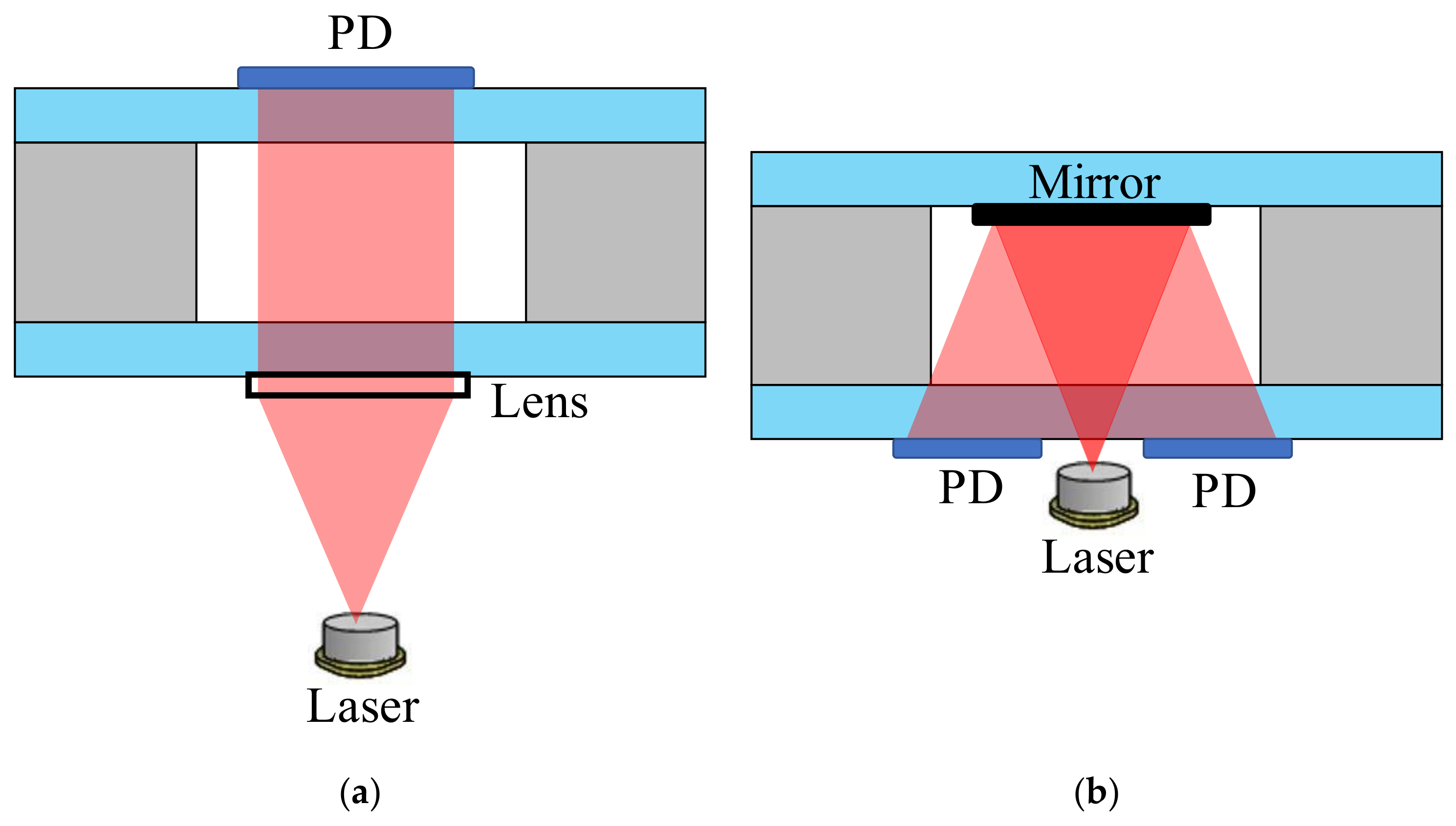


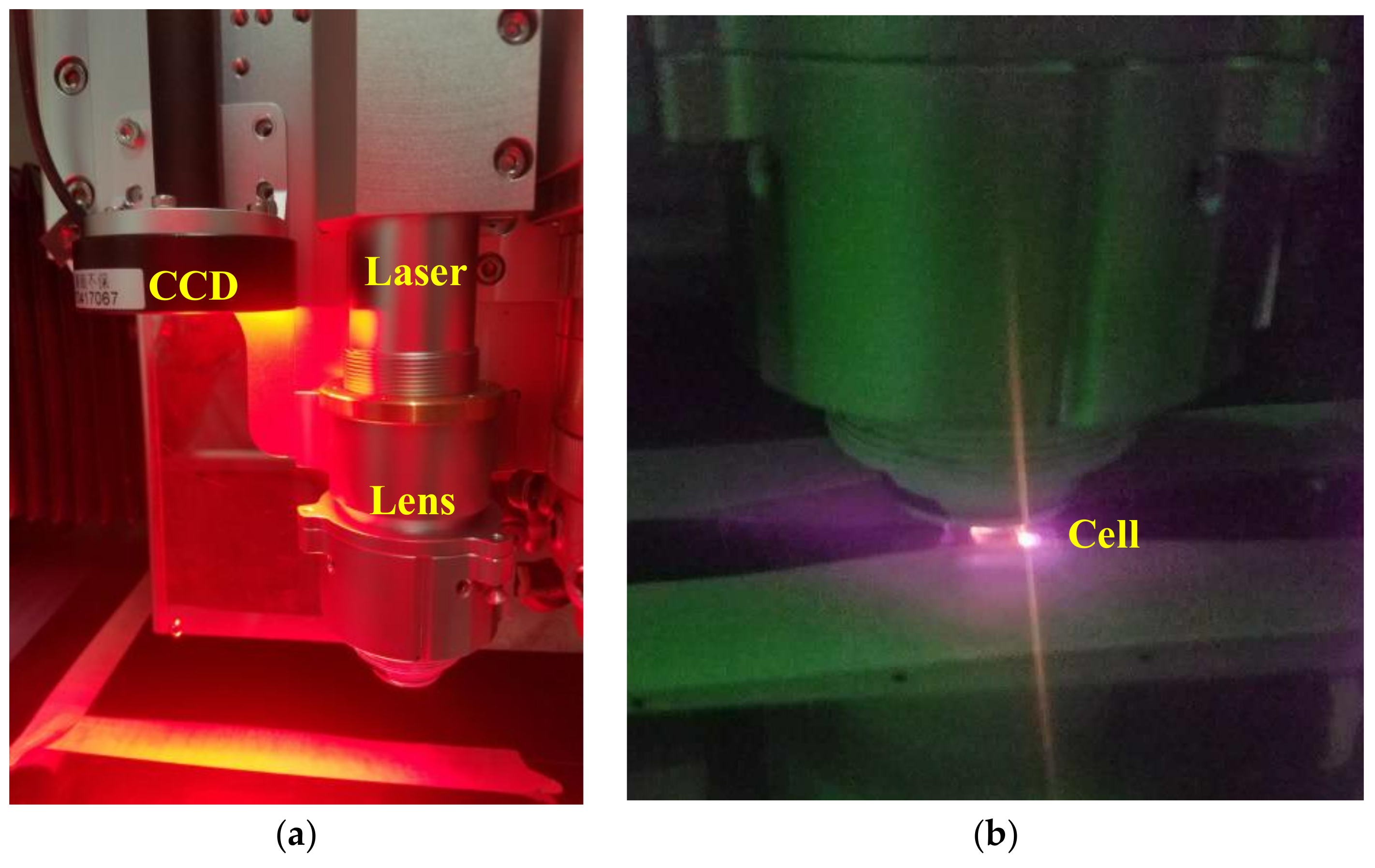
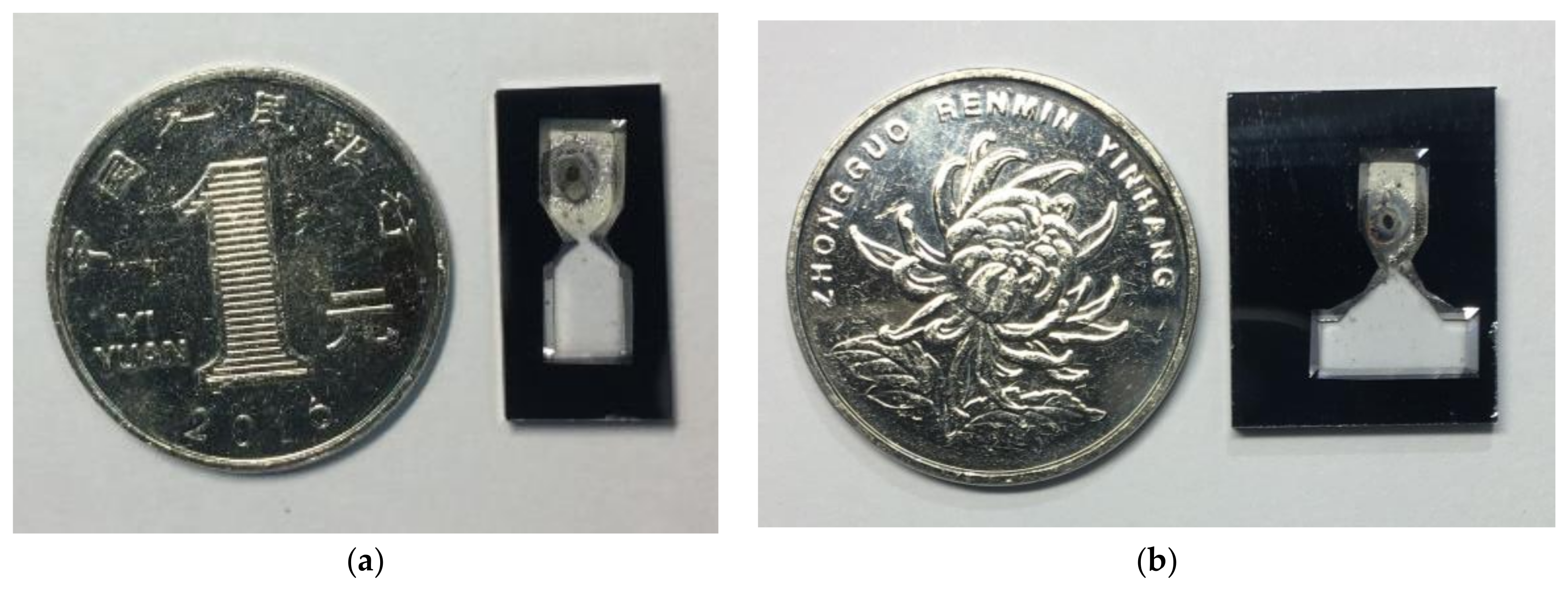

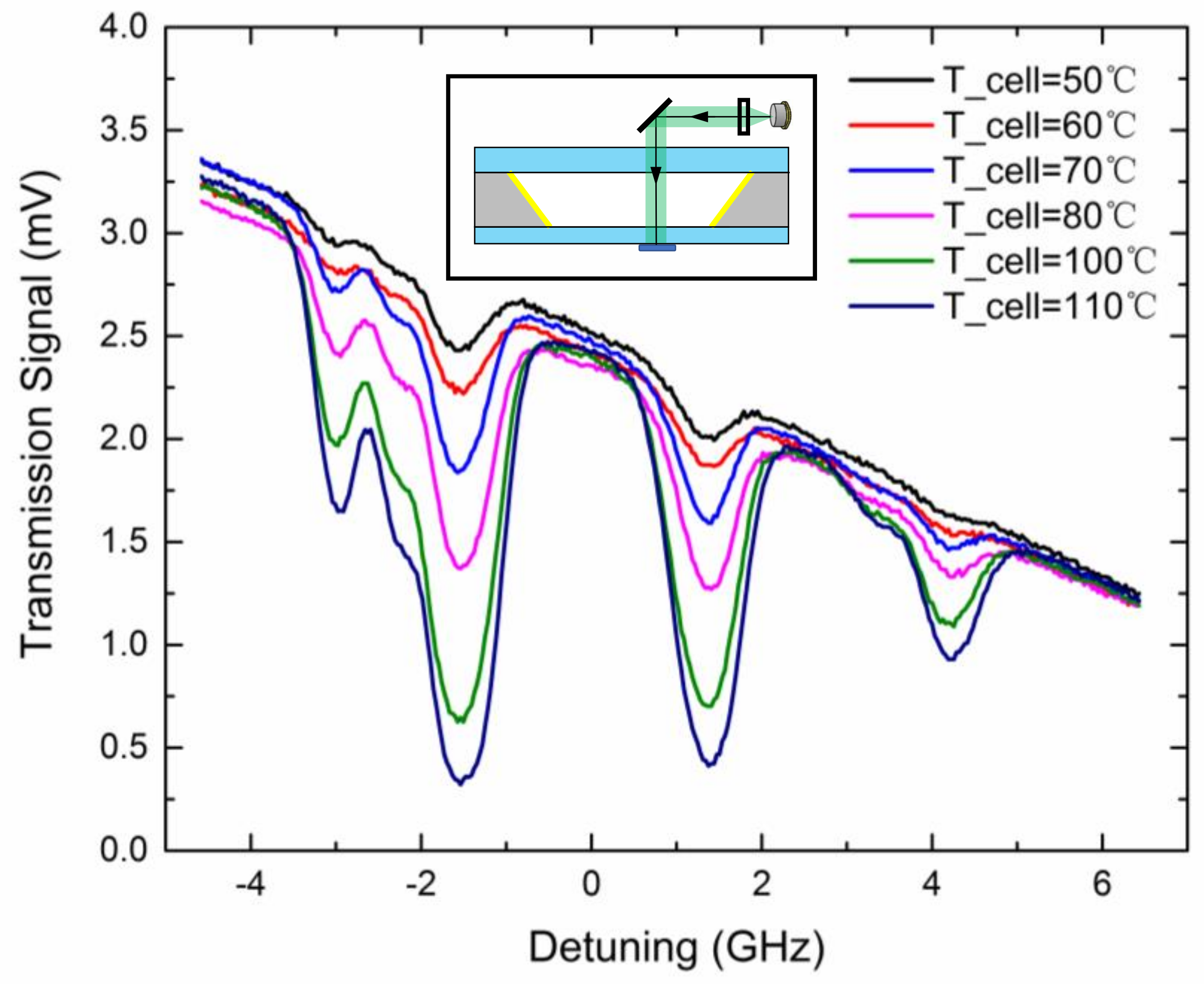

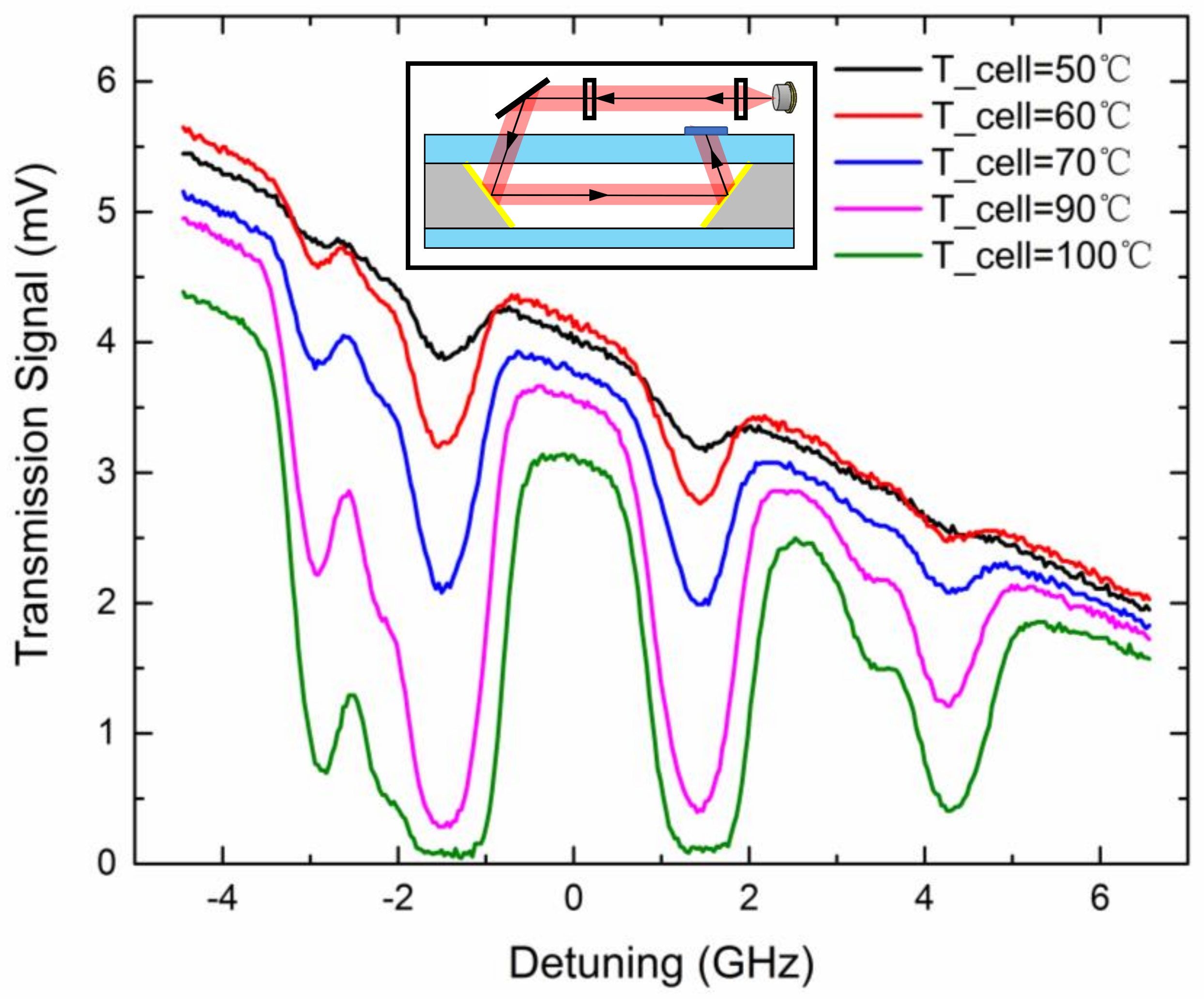

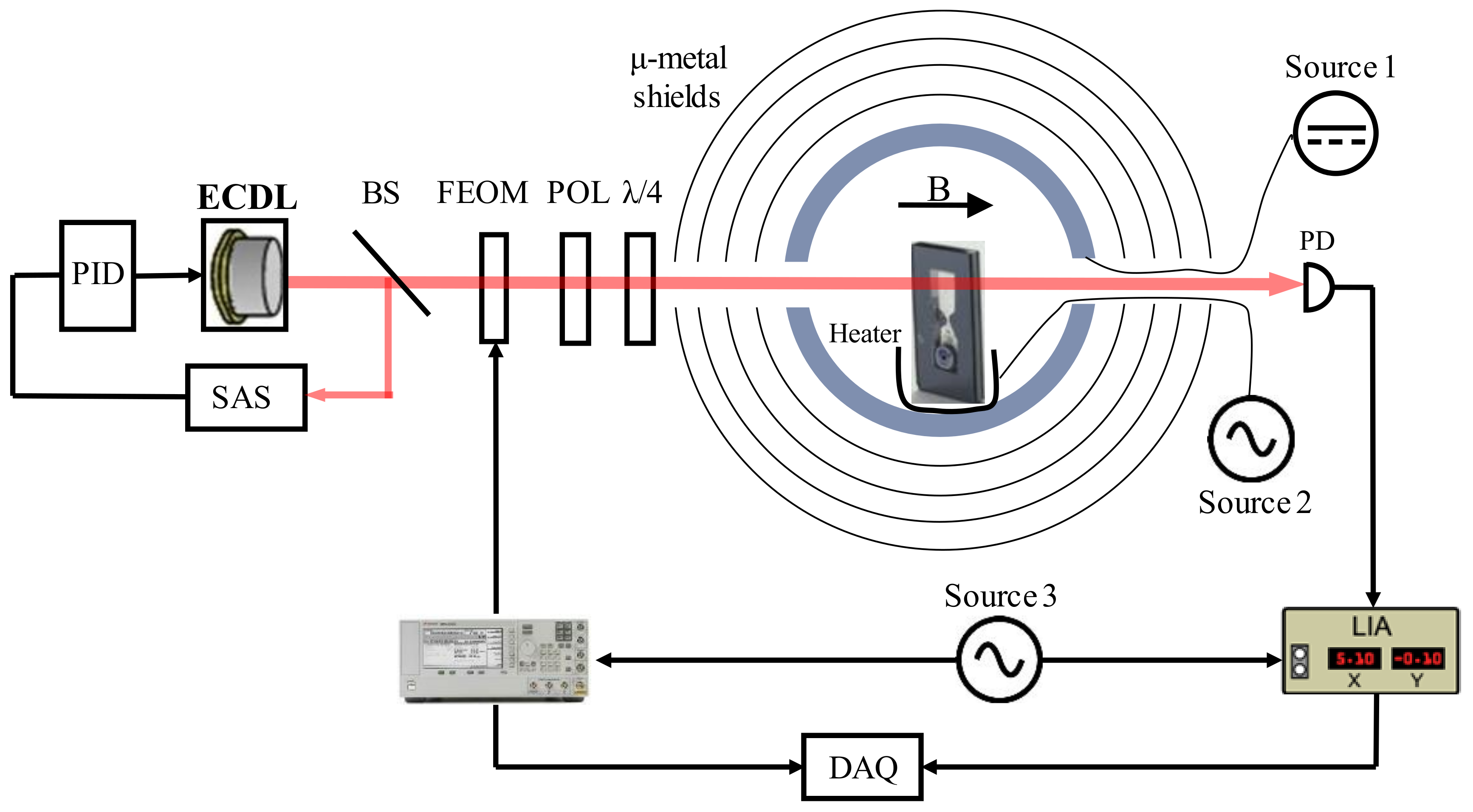
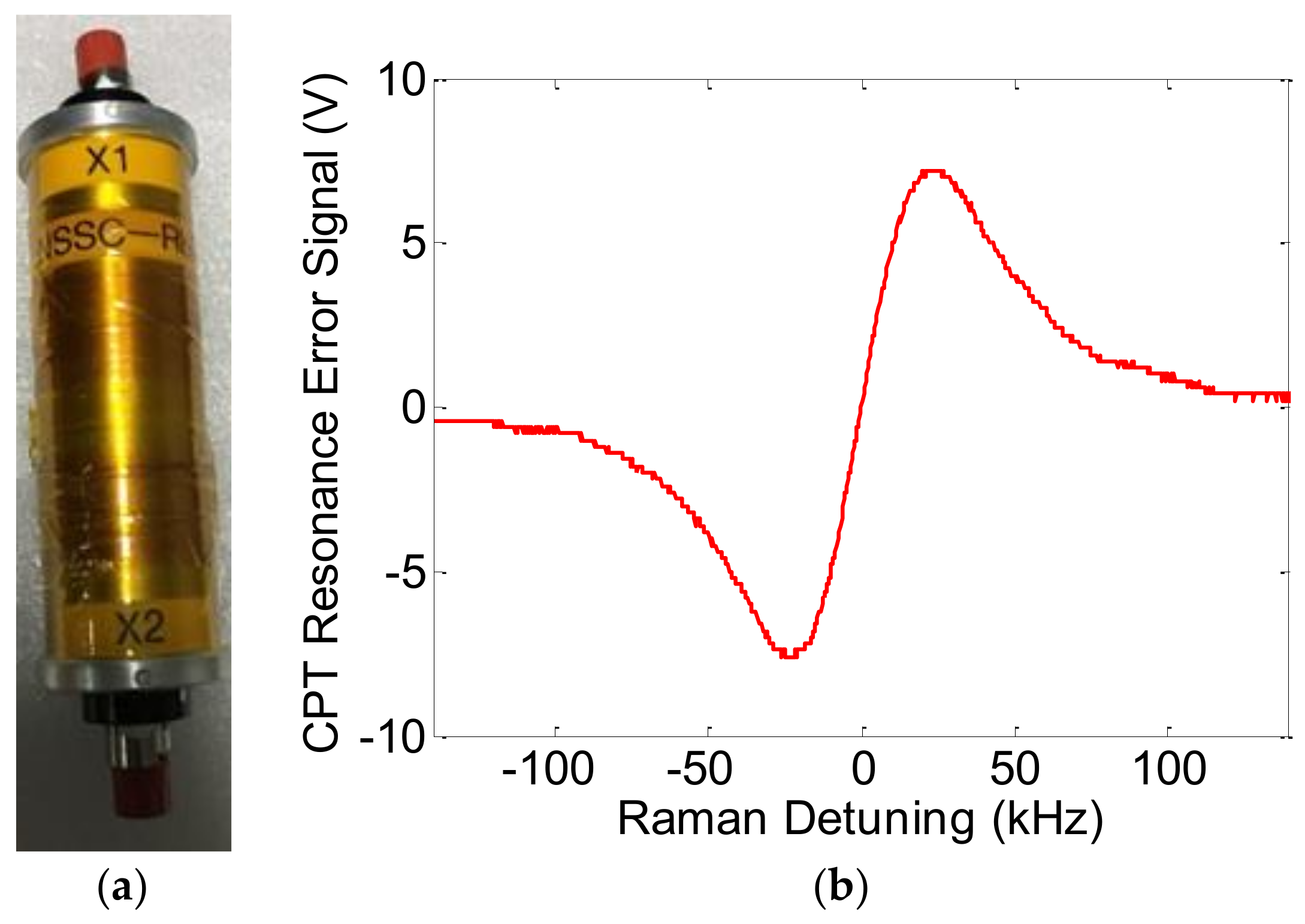
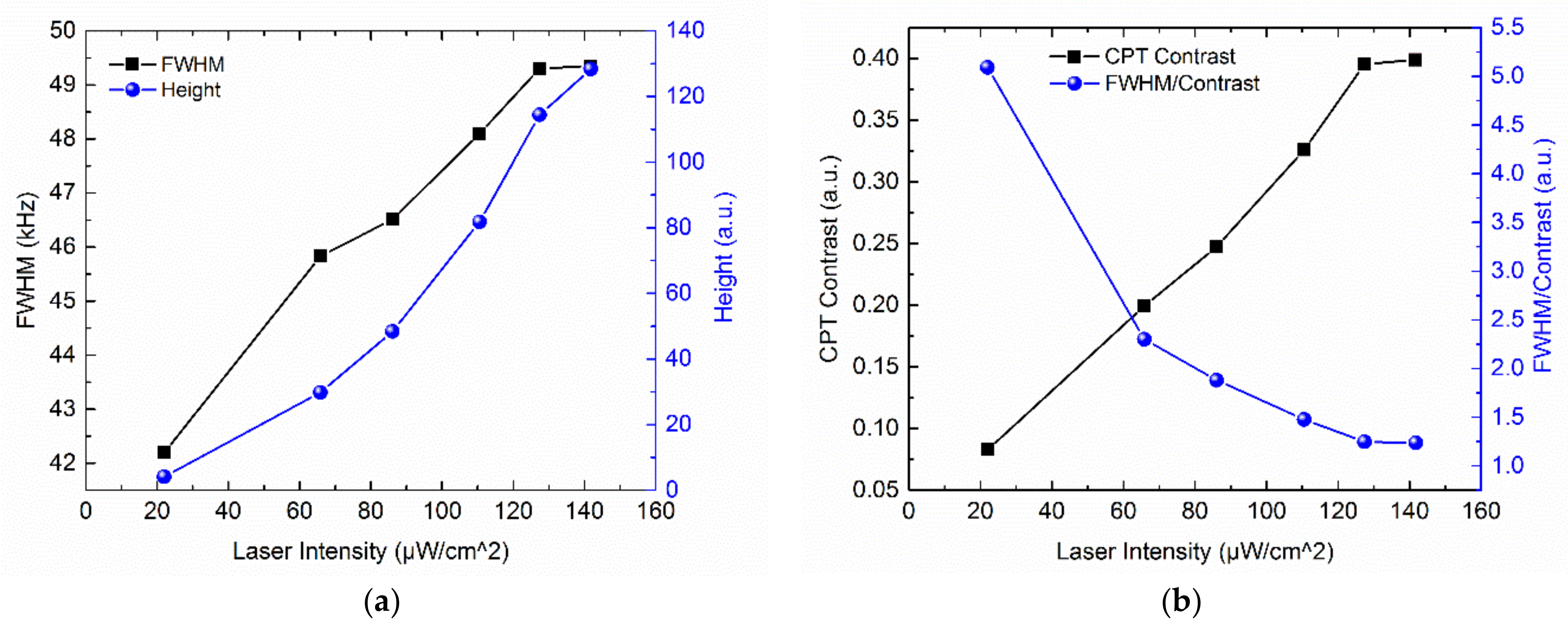
© 2018 by the authors. Licensee MDPI, Basel, Switzerland. This article is an open access article distributed under the terms and conditions of the Creative Commons Attribution (CC BY) license (http://creativecommons.org/licenses/by/4.0/).
Share and Cite
Han, R.; You, Z.; Zhang, F.; Xue, H.; Ruan, Y. Microfabricated Vapor Cells with Reflective Sidewalls for Chip Scale Atomic Sensors. Micromachines 2018, 9, 175. https://doi.org/10.3390/mi9040175
Han R, You Z, Zhang F, Xue H, Ruan Y. Microfabricated Vapor Cells with Reflective Sidewalls for Chip Scale Atomic Sensors. Micromachines. 2018; 9(4):175. https://doi.org/10.3390/mi9040175
Chicago/Turabian StyleHan, Runqi, Zheng You, Fan Zhang, Hongbo Xue, and Yong Ruan. 2018. "Microfabricated Vapor Cells with Reflective Sidewalls for Chip Scale Atomic Sensors" Micromachines 9, no. 4: 175. https://doi.org/10.3390/mi9040175



